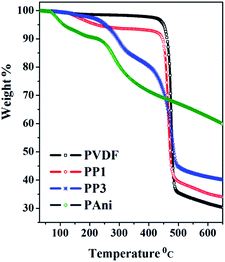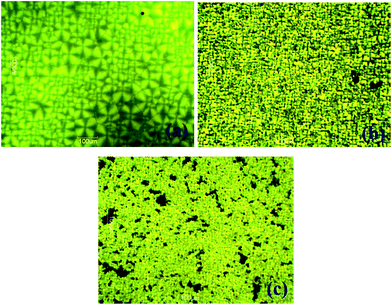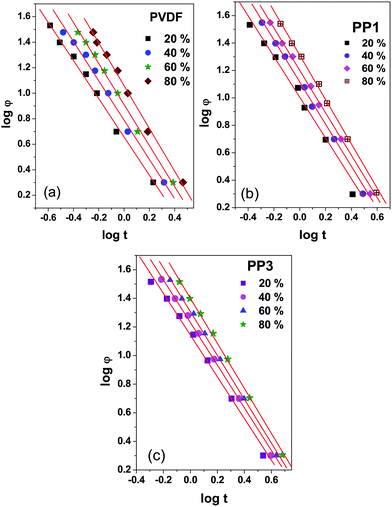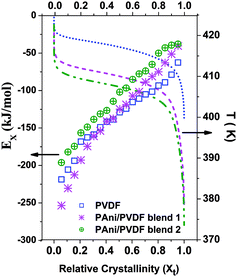Correlation between nucleation, phase transition and dynamic melt-crystallization kinetics in PAni/PVDF blends†
Swarup Biswasa,
Bula Duttab and
Subhratanu Bhattacharya*a
aDepartment of Physics, University of Kalyani, Kalyani, Nadia, 741235, West Bengal, India. E-mail: subhratanu1@gmail.com
bDepartment of Chemistry, P. D. Women's College, Jalpaiguri-735101, West Bengal, India
First published on 18th August 2015
Abstract
In this study, polyaniline (PAni)/poly(vinylidene fluoride) (PVDF) blends of different compositions were prepared by in situ chemical polymerization of aniline in a mixture of PVDF and dimethylformamide (DMF). Fourier transform infrared spectroscopy (FT-IR), thermo-gravimetry (TG) and differential scanning calorimetry (DSC) were utilized to understand the effect of different amounts of in situ PAni loading on the crystalline structure, phase transition and dynamic melt-crystallization kinetics of PVDF. The images for morphology obtained using scanning electron microscopy and polarizing optical microscopy also provided the confirming evidences. FT-IR studies revealed that the transition of the crystalline structure (from β- to α-phase) of pure PVDF during recrystallization is hindered by the incorporation of PAni within the matrix. The dynamic crystallization kinetics data were analysed with different macroscopic models to describe the polymer crystallization, and the parameters obtained from the analyses were correlated with the structural evidence to verify their applicability for the systems under investigation. Values for the effective activation energy (EX) of the crystallization process of PVDF and its blends were calculated by the differential isoconversional methods of Friedman. It was observed that, although PAni acted as an effective nucleating agent to induce a great number of heterogeneous nuclei within the blends, it actually delayed the overall crystallization process. The increased values of the crystal growth parameters obtained from the analysis of the temperature-dependent EX by the modified Hoffman–Lauritzen theory also support the above mentioned interpretations.
1. Introduction
Poly(vinylidene fluoride) (PVDF) is an important chemically stable, semi-crystalline material with extraordinary properties, including good toughness, flexibility, and predominantly outstanding electrical properties such as ferro-, piezo-, and pyro-electricity.1,2 PVDF is well-known for its polymorphism, and can display five different polymorphs depending on its processing conditions.2 The α-phase is the most common and stable polymorph of PVDF, which is generally produced from the melt crystallization of PVDF at atmospheric pressure.1 However, from an application perspective, β-PVDF is the most important polymorph because it possesses the largest spontaneous polarization per unit cell and thus exhibits superior ferroelectric and piezoelectric properties. Therefore, the enhancement of the polar β-phase and simultaneous suppression of the nonpolar α-phase in PVDF materials are of great importance for their widespread application, and have been studied extensively in the recent years.2–6For a crystallizable polymeric system, crystallization is considered to occur from two successive events, first homogeneous or heterogeneous nucleation (caused by impurities, external additives or other effects), followed by growth of the crystals with increasing crystallization time.7 In these procedures, nucleation is the key parameter that can control the structure and phase transition of the polymer.7 Nucleation agents assist secondary nucleation by providing a surface on which the melt crystallizes. During crystallization, they either influence the crystallization kinetics, the crystallite size, or the crystalline phase.8 The overall free energy associated with nucleation combines the favorable term arising from chain aggregation and the unfavorable term associated with the interface formation.8 Thus, the efficiency of nucleation agents depends on increase in the surface area and decrease in the nucleation barrier required to enhance the heterogeneous nucleation process.
Consequently, control of the spherulite size or crystalline phase by the addition of nucleation agents is an attractive method to modify and improve the physical properties of bulk crystalline polymers for specific end uses. From earlier reports, it was observed that the heterogeneous nucleation processes and phase transition of PVDF can be influenced either by blending it with different organic compounds such as poly(methyl methacrylate),9–11 poly(vinyl acetate),12 nylon-6,13 poly(butylene adipate),14 poly(ethylene terephthalate)15 or by incorporating nanoparticles,16 nanoclay,17,18 or carbon nanotubes (CNTs)19 within its matrix. It was observed that in the blended polymeric systems, due to the restriction effect of the additive component on the nucleation and growth of the crystalline component, the crystallization of PVDF is sometimes hindered and the melting temperature of the blends is decreased, as compared with the pure crystalline component. It was also reported8 that the nucleation and phase transition of the miscible polymer blends can be influenced by the surface charge of the organic nucleation agent and that nucleation agents with positively charged surfaces are most effective to induce more extended PVDF chain conformers in the polar β-phase.8
Conducting organic materials such as polyaniline (PAni) have found widespread application in recent times. These materials, doped with bulky organic acids and being very organic in nature, offer excellent compatibility with semi-crystalline polymer matrices such as PVDF.20,21 Therefore, it is highly expected that blending doped polyaniline (PAni) with PVDF may influence the overall phase transition and nucleation of PVDF due to the presence of radical cations on the doped polyaniline chain. Recently, several blends20–24 of PVDF with PAni or its derivatives25 have been prepared using different methods to study their electrical and other properties21–23,26 due to their numerous application potentials. However, to the best of our knowledge, exploration of the heterogeneous nucleation ability of conducting PAni in semi-crystalline PVDF polymer, which is of great research interest, has not been addressed until this present study.
Based on the above considerations, an attempt has been made in the present study to investigate the influence of camphorsulfonic acid (CSA)-doped PAni on the nucleation, phase transition and growth of PVDF crystals by studying the melt-crystallization kinetics of different PAni/PVDF blends using differential scanning calorimetry (DSC). To improve the miscibility between PAni and PVDF, the blends were processed by in situ chemical polymerization of aniline in a mixture of PVDF and dimethylformamide (DMF).20 To study the crystallization kinetics of these blended polymeric systems, a constantly changing environment (non-isothermal) rather than an isothermal one was implemented, because this is the usual environment in the melt processing of polymers for industrial applications. The experimentally obtained kinetic data were analysed by several existing theoretical models. An isoconversional technique was used to evaluate the variation of the effective activation energy of the blends during the crystallization process. Thermo-gravimetric analysis, infrared spectroscopy, scanning electron microscopy (SEM) and polarizing optical microscopy (POM) were also used to support the results and to obtain direct evidence for the crystalline morphologies and phase transition of the blends.
2. Experimental
2.1 Materials
Aniline monomer (Merck) was distilled under vacuum before the polymerization reactions. PVDF (Mw 534![[thin space (1/6-em)]](https://www.rsc.org/images/entities/char_2009.gif) 000) (Sigma Aldrich), ammonium persulfate ((NH4)2S2O8) (APS) [98%, Sigma Aldrich], N,N-dimethylformamide (DMF) (Sigma Aldrich), camphorsulfonic acid (CSA) (Sigma Aldrich) and chloroform (Merck) were used as received.
000) (Sigma Aldrich), ammonium persulfate ((NH4)2S2O8) (APS) [98%, Sigma Aldrich], N,N-dimethylformamide (DMF) (Sigma Aldrich), camphorsulfonic acid (CSA) (Sigma Aldrich) and chloroform (Merck) were used as received.
2.2 Synthesis of PVDF/PAni blends
In a typical synthesis, 1.0 g of PVDF was dissolved in 10 ml of DMF at 70 °C. The solution was then cooled at room temperature. Pre-distilled aniline monomer was then added with stirring. Stoichiometric amounts of CSA and APS were dissolved in 20 ml DMF at room temperature. To initiate the polymerization of aniline, the solution containing CSA + APS was slowly added to the An/PVDF/DMF solution with a subsequent addition of 50 ml chloroform into the reaction solution under vigorous stirring. The polymerization reaction was allowed to proceed for 5 hours under stirring at room temperature to obtain a dark green miscible blend of PAni and PVDF, which remained as a kinetically stable dispersion within the solution. At the end of the polymerization, de-ionized water was added into the system to precipitate the blend. No separated PAni was found in the aqueous part, confirming the entire confinement of in situ synthesized PAni within the hydrophobic PVDF matrix. The precipitated blends were filtered and washed several times with de-ionized water and dried under a dynamic vacuum for 24 hours at 70 °C to obtain its final form. Two different PAni/PVDF blends with different concentrations of aniline (Table 1) were prepared, and are referred as sample PP1 and sample PP3. The ratio of CSA![[thin space (1/6-em)]](https://www.rsc.org/images/entities/char_2009.gif) :
:![[thin space (1/6-em)]](https://www.rsc.org/images/entities/char_2009.gif) An and APS
An and APS![[thin space (1/6-em)]](https://www.rsc.org/images/entities/char_2009.gif) :
:![[thin space (1/6-em)]](https://www.rsc.org/images/entities/char_2009.gif) An were maintained fixed (1
An were maintained fixed (1![[thin space (1/6-em)]](https://www.rsc.org/images/entities/char_2009.gif) :
:![[thin space (1/6-em)]](https://www.rsc.org/images/entities/char_2009.gif) 1) for each blend. A pure PVDF film was also obtained after processing 1.0 g PVDF through DMF accordingly. Pure polyaniline was also synthesized for comparison, with the same stoichiometric ratio between An, CSA and APS as used for PP3 and DMF as the solvent without PVDF (Table 1).
1) for each blend. A pure PVDF film was also obtained after processing 1.0 g PVDF through DMF accordingly. Pure polyaniline was also synthesized for comparison, with the same stoichiometric ratio between An, CSA and APS as used for PP3 and DMF as the solvent without PVDF (Table 1).
| PVDF (gm) | An [M] | CSA [M] | APS [M] | Sample |
|---|---|---|---|---|
| 1 | 0 | 0 | 0 | PVDF |
| 1 | 0.1 | 0.1 | 0.1 | PP1 |
| 1 | 0.3 | 0.3 | 0.3 | PP3 |
| 0 | 0.3 | 0.3 | 0.3 | PAni |
2.3 Differential scanning calorimetry (DSC) and thermo-gravimetric analysis (TGA)
The non-isothermal crystallization experiments were carried out using a Netzsch DSC 214 Polyma instrument under a nitrogen atmosphere with temperature calibrated with indium. In practice, ∼10 mg of polymer films was encapsulated in concavus aluminium crucibles covered by lids. The samples were heated to 200 °C at 10 K min−1 and kept for 10 min at this temperature to eliminate the thermal history, and then cooled to room temperature at various cooling rates of 2, 5, 10, 15, 20, 25 and 30 K min−1. The percentage of PAni within the PVDF matrix was evaluated by thermo-gravimetric analysis (TGA). TGA was performed with a Netzsch TG 209 F3 Tarsus system at a heating rate of 10 K min−1 under a nitrogen environment, and the samples were scanned from room temperature to 700 °C.2.4 Scanning electron microscopy and optical microscopy
The dispersion of conducting PAni in PVDF matrix was characterized with EVO LS 10 (Zeiss) SEM at an accelerating voltage of 20 kV. The surface of the sample was gold coated before SEM observation. The surface morphology for all the samples was evaluated before and after the crystallization experiments.The morphology of spherulitic growth during the crystallization of PVDF and its composites was observed by polarizing optical microscopic investigation using an Olympus BX41 microscope attached with a DP11 digital camera system (Olympus). The temperature variation of the samples was controlled by a Mettler Toledo FP90 Central processor. The samples were pre-heated to 200 °C, held for 5 min and then cooled.
2.5 Fourier transform infrared (FT-IR) spectroscopy
Fourier transform infrared (FT-IR) spectra of the samples were obtained on a Shimadzu IR affinity 1S FT-IR spectrometer, equipped with a single-reflection diamond attenuated total reflection Fourier transform infrared (ATR-FTIR) sampling module. The spectra were acquired using 64 scans and 4 cm−1 resolution within a spectral range of 4000–400 cm−1. The ATR-FTIR spectra for all the samples were obtained before and after melt crystallization.3. Results and discussion
3.1 Thermal stability
The thermo-gravimetric behaviours of pure PVDF, PAni/PVDF blends and pure PAni have been compared in Fig. 1. The onset degradation temperature of the pure PVDF chain27 is observed around 400 °C. A similar pattern of weight loss can be observed for the blends as well; however, they exhibit a considerable weight loss at considerably lower temperatures. The weight loss detected within the temperature range from 200 °C to 300 °C can be ascribed to the loss of bonded water and the dopant CSA of synthesized PAni within the PVDF matrix,25,28 as also observed for pure PAni. The TGA curve of PP3 shows a considerably higher weight loss because the amount of dopant in the blend is higher. From TGA, the percentage of in situ polymerized CSA-doped PAni within the PVDF matrix was estimated to be ∼4.3% and ∼9.67% for PP1 and PP3, respectively.3.2 Molecular structure and crystalline phase content
By comparing the FTIR spectra of PVDF and PAni/PVDF blends before and after the melt-crystallization process, as shown in Fig. 2(a) and (b), respectively, it can be observed that the in situ synthesized PAni within the PVDF matrix considerably influences the PVDF molecular structure and phase content. Fig. 2a depicts the spectra of solvent-casted pure PVDF and its blends. The spectrum of pure CSA-doped PAni is also included in the figure for comparison. It is well documented23,24,29 that the absorption bands observed near 1072 and 876 cm−1 (γCH2 of PVDF4) are sensitive to the crystallinity of PVDF. The bands situated near 488, 532, 615, 764, 795, 974 and 1149 cm−1 are attributed to the α-PVDF phase, while those obtained near 511, 840 and 1275 cm−1 are assigned to β-PVDF phase.23 For the spectrum of pure PAni, the overwhelming presence of the characteristic stretching vibrations at 1582 cm−1 (γC![[double bond, length as m-dash]](https://www.rsc.org/images/entities/char_e001.gif) C for quinoid rings), 1484 cm−1 (γC
C for quinoid rings), 1484 cm−1 (γC![[double bond, length as m-dash]](https://www.rsc.org/images/entities/char_e001.gif) C for benzenoid rings), 1297 cm−1 (γC–N for the secondary aromatic amine), 1125 and 798 cm−1 (γC–H aromatic in-plane and out-of-plane deformation for the 1,4-disubstituted benzene) support the formation of PAni. It is important to note that the intensity of the quinoid band of the PAni chain is higher than the benzenoid band, indicating that the PAni is in the conducting emeraldine salt state due to CSA doping. In the PAni/PVDF blends, although most of the bands associated with PAni coincide with the dominating absorption bands of PVDF, the feeble presence of the bands near 1582 cm−1 and 1484 cm−1 in both the blends (higher intensity for PP3) with an identical intensity as observed for pure PAni confirms the presence of PAni in the blend. This is also confirmed from Fig. 2a, where both pure PVDF and its blends possess a β-crystalline phase, as manifested by the noticeable peak near 840 cm−1 in all the spectra. The feeble presence of the α-phase in PVDF almost totally diminishes with the increase of PAni content within the matrix.
C for benzenoid rings), 1297 cm−1 (γC–N for the secondary aromatic amine), 1125 and 798 cm−1 (γC–H aromatic in-plane and out-of-plane deformation for the 1,4-disubstituted benzene) support the formation of PAni. It is important to note that the intensity of the quinoid band of the PAni chain is higher than the benzenoid band, indicating that the PAni is in the conducting emeraldine salt state due to CSA doping. In the PAni/PVDF blends, although most of the bands associated with PAni coincide with the dominating absorption bands of PVDF, the feeble presence of the bands near 1582 cm−1 and 1484 cm−1 in both the blends (higher intensity for PP3) with an identical intensity as observed for pure PAni confirms the presence of PAni in the blend. This is also confirmed from Fig. 2a, where both pure PVDF and its blends possess a β-crystalline phase, as manifested by the noticeable peak near 840 cm−1 in all the spectra. The feeble presence of the α-phase in PVDF almost totally diminishes with the increase of PAni content within the matrix.
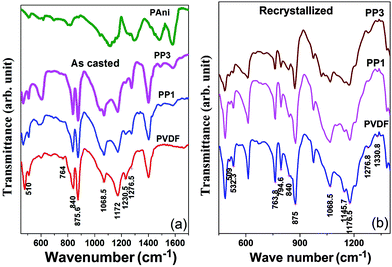 | ||
| Fig. 2 FTIR spectra of PVDF and its blends obtained at different conditions: (a) as-casted and (b) recrystallized. Spectrum of pure PAni is also shown with the as-casted spectra for comparison. | ||
The FTIR spectra for the samples obtained after the melt-crystallization are demonstrated in Fig. 2b within the wave number range from 1400 to 450 cm−1. As observed, the area of both the bands at 1072 and 876 cm−1 remain almost the same, indicating that the degree of crystallinity of the recrystallized samples remains almost unchanged. It is also worth noting that there is a transition of the crystalline structure (from β- to α-phase) during the melt crystallization of PVDF (noticeable band near 764 cm−1), while the trace of the β-phase is almost absent (Fig. 2b). However, the incorporation of PAni within the PVDF matrix prevents the complete transformation of the β- to α-phase in the blends, as manifested by the presence of the band at 840 cm−1 in the spectra, whose intensity increases with higher PAni content within the matrix. Simultaneously, the band intensity corresponding to the α-phase diminishes with the increase of PAni within the matrix, as compared to pure PVDF. The role of PAni in the phase transformation can be revealed more conveniently by evaluating the relative fraction of the β-phase within the samples. The ratio of the absorption areas of the major bands corresponding to the α- and β-phases, denoted as A764 and A840, respectively, to that of the band at 876 cm−1 (A876) are compared in Fig. 3a. Considering that the infrared absorption follows the Lambert–Beer law for a system containing α- and β-phases, the fraction of the β-phases, F(β), can be calculated as follows:6,29
 | (1) |
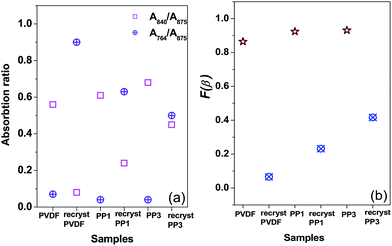 | ||
| Fig. 3 (a) Absorbance ratios and (b) F(β) obtained from the FT-IR spectra for neat PVDF and its blends under different conditions. | ||
It can be observed from Fig. 3a that the ratios corresponding to A840/A875 and A764/A875 for pure PVDF decrease and increase, respectively, upon recrystallization, which leads to a lower value of F(β) (Fig. 3b). For the blend obtained with in situ synthesized PAni within the PVDF network, it can be observed that the α-phase is continuously diminished (decreasing value of A764/A875) with a simultaneous rise in the β-phase (higher values of A840/A875), which demonstrates a significant increase in F(β). Thus, the above mentioned study clearly reveals that the presence of in situ synthesized PAni significantly influences the crystal structure and phase transformation of the PVDF and, moreover, it hinders the transformation of β-PVDF to its α-phase during recrystallization.
3.3 SEM observations
The SEM micrographs of the as-casted films of PVDF and the PAni/PVDF blends are shown in Fig. 4a, c and e. As observed, pure PVDF contains uniform spherical particles, which indicate the formation of perfect spherulites with fewer nucleation sites, which produces larger crystallites. With the incorporation of PAni, the spheres overlap with each other and their size gradually decreases, which is attributed to the strong mutual interaction between the blend components and the increase in the nucleation sites and the formation of imperfect crystallites. Moreover, it can be clearly observed that in the blend with a higher PAni concentration (PP3) (Fig. 4e), the PAni phase is uniformly dispersed within the PVDF matrix in the form of small conductive islands.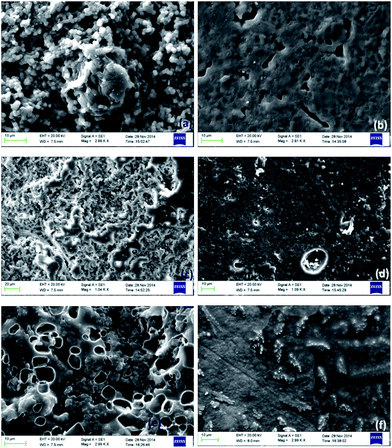 | ||
| Fig. 4 Scanning electron micrographs of as-casted and recrystallized PVDF (a) and (b); PP1 (c) and (d) and PP3 (e) and (f), respectively. | ||
Fig. 4b, d and f show the SEM micrographs of the recrystallized PVDF and its blends.
As shown, the PVDF sample displays a rough surface morphology consisting of large spherulites, while both PP1 and PP3 exhibit a comparatively smooth surface. It can also be observed that both the blended samples have notable crystalline particles compared to that of pure PVDF, whose size decreases and numbers increase with increasing PAni content. From the above mentioned observation, it can be inferred that, with the insertion of PAni, the entanglement of PVDF chains may occur, resulting in large numbers of nucleation sites. However, at high PAni content, PVDF is surrounded by large numbers of conducting islands, which hinder the larger growth of crystals, and thus smaller, imperfect and non-spherical crystallites are formed.
3.4 Polarizing optical microscopy observations
The impact of PAni on the crystallization of PVDF was also demonstrated by POM images of PVDF and PAni/PVDF blends, as seen in Fig. 5. For the pure PVDF, the POM image exhibits a normal spherulitic structure with perfect Maltese extinction crosses, and the spherulitic size is around 100 μm. The spherulitic size decreases and their number increases significantly due to the incorporation of PAni into PVDF. This suggests that the crystallization of PVDF is greatly affected by the presence of PAni within the PVDF matrix. Herein, PAni acts as an effective nucleating agent to induce a great number of heterogeneous nuclei and to simultaneously generate large numbers of small spherulites within a limited space.Moreover, with a higher PAni content, the spherulitic size of the blend becomes even smaller and difficult to be evaluated, which further confirms the greater heterogeneous nucleation effect of the PAni within this blend. However, it is worth noting that the growth of smaller spherulites, as illustrated by both the SEM and POM micrographs, often causes more crystal defects, leading to a lower degree of crystallinity.
Thus, to achieve more insight into the effect of the in situ incorporation of PAni within the PVDF matrix, a detailed study regarding the dynamic melt-crystallization kinetics of PVDF and its blends was performed.
3.5 Effect of cooling rate and in situ PAni loading on the non-isothermal melt-crystallization behavior of PVDF
The typical dynamic melt-crystallization thermo-grams measured at various cooling rates for pure PVDF and its blends are shown in Fig. 6. Table 2 shows the data of the non-isothermal crystallization peak temperature corresponding to the maximum crystallization rate (TC) and crystallization enthalpy (ΔHC) obtained at different cooling rates for pure PVDF and its blends. ΔHC was calculated using the sample mass. It can be observed that for both PVDF and PAni/PVDF blends, as the cooling rate increases, TC considerably shifts to a lower temperature with a simultaneous substantial increase in ΔHC. The observed difference in ΔHC at different cooling rates is analogous to the previously observed reports for different polymeric systems.30–32 Because the crystallization process is time dependent, lower cooling rates provide macromolecular chains enough time to change their conformation, i.e., availability of a longer time for nucleation and crystallization. Therefore, the lower cooling rate facilitates the crystallization. Because the crystallization is an exothermic process and can be accelerated at a lower temperature, at higher cooling rates, high crystallization enthalpy (Table 2), i.e. a broader exothermic crystallization peak, arises (Fig. 6).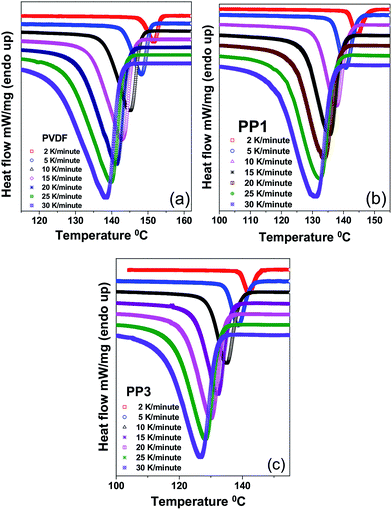 | ||
| Fig. 6 Non-isothermal crystallization patterns (exothermic curves) of PVDF (a) and PAni/PVDF blends (b) and (c) at different cooling rates. | ||
| Sample | φ (K min−1) | T*m (°C) | XC (%) | TC (°C) | ΔHC (J g−1) | t1/2 (min) |
|---|---|---|---|---|---|---|
| PVDF | 2 | 174 | 48.7 | 151.6 | 38.61 | 1.97 |
| 5 | 148.2 | 45.75 | 1.11 | |||
| 10 | 145.0 | 47.96 | 0.73 | |||
| 15 | 142.9 | 48.87 | 0.58 | |||
| 20 | 141.2 | 50.85 | 0.49 | |||
| 25 | 139.8 | 51.41 | 0.40 | |||
| 30 | 138.3 | 53.24 | 0.36 | |||
| PP1 | 2 | 165 | 41.9 | 144.5 | 37.72 | 3.18 |
| 5 | 140.7 | 42.09 | 2.44 | |||
| 10 | 137.6 | 43.32 | 1.24 | |||
| 15 | 135.4 | 43.69 | 1.08 | |||
| 20 | 133.8 | 44.08 | 0.76 | |||
| 25 | 132.2 | 45.39 | 0.64 | |||
| 30 | 131.0 | 45.50 | 0.50 | |||
| PP3 | 2 | 161 | 31.1 | 142.1 | 24.09 | 4.12 |
| 5 | 138.6 | 27.95 | 2.84 | |||
| 10 | 134.8 | 29.28 | 1.52 | |||
| 15 | 132.1 | 30.02 | 1.16 | |||
| 20 | 129.9 | 29.42 | 0.95 | |||
| 25 | 128.2 | 29.23 | 0.77 | |||
| 30 | 126.7 | 28.54 | 0.62 |
However, the most relevant observation is the influence of PAni concentration on the crystallization temperature of PVDF for a particular cooling rate. There is a decrease in both TC and ΔHC when PVDF is blended with PAni. The decrease in TC for the blends with increasing PAni content, irrespective of the cooling rate, can be attributed to the steric dipole/dipole interactions between the (![[double bond, length as m-dash]](https://www.rsc.org/images/entities/char_e001.gif) N–H)+ group of PAni and the (–[CH2–CF2]n–) group of PVDF, hindering the α-phase and favoring the trans-conformation of the highly polar β-phase during melt crystallization,29 as evidenced from the FTIR observation.
N–H)+ group of PAni and the (–[CH2–CF2]n–) group of PVDF, hindering the α-phase and favoring the trans-conformation of the highly polar β-phase during melt crystallization,29 as evidenced from the FTIR observation.
The absolute crystallinity fraction XC was estimated (Table 2) from the enthalpy evolved during crystallization using the following equation:30
 | (2) |
In the dynamic crystallization mechanism, it is generally considered that the development of crystallinity is linearly proportional to the evolution of heat released during the crystallization. Based on the above consideration, the relative degree of crystallinity (Xt) is defined as the ratio of crystallinity at any time t to the crystallinity as time approaches infinity, and can be expressed as a function of the crystallization temperature as follows:34
 | (3) |
| t = (T0 − T)/φ | (4) |
Fig. 7 shows the relative crystallinity (Xt) with respect to temperature for the non-isothermal crystallization kinetics process. All the curves have the same sigmoid shape, indicating that only the retardation effect of the cooling rate separates them from each other. The transformation from temperature to time is performed using eqn (4) for different constant cooling rates and is shown in Fig. 8 for the different samples. All the Xt vs. time curves at various cooling rates have the same characteristic sigmoid shape. Each of the curves can be divided into four segments. First, a nonlinear part, characteristic of the initiation of nucleation, followed by a linear part associated with primary crystallization, and a subsequent second nonlinear part with slight deviation, which is a signature of secondary crystallization. The formation of a plateau in the final part of all these curves is perhaps due to spherulite impingement or the approach of saturation in the crystallization process. The lower plateau is the cooling rate, whereas the larger is the temperature (time) range at which the crystallization occurs, which indicates that the transformation is controlled by nucleation.
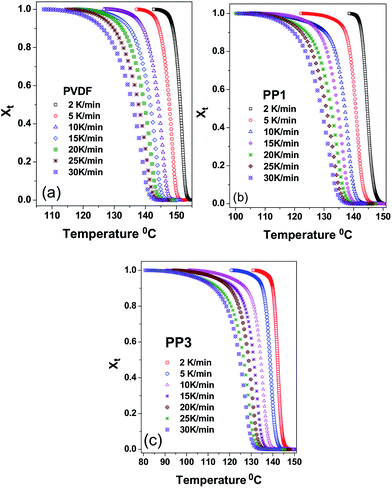 | ||
| Fig. 7 Temperature variation of relative degree of crystallinity during crystallization process of (a) PVDF and (b) and (c) PAni/PVDF blends. | ||
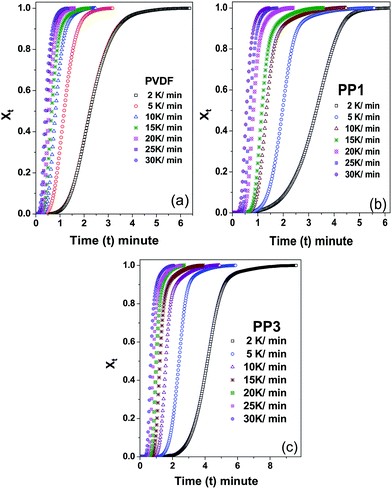 | ||
| Fig. 8 Time variation of relative degree of crystallinity during the crystallization process of (a) PVDF and (b) and (c) PAni/PVDF blends. | ||
The half non-isothermal crystallization time (t1/2), defined as the time taken to reach the relative crystallinity at a value of 50%, can be obtained from the Xt vs. time curve, as summarized in Table 2 for PVDF and PAni/PVDF blends at different cooling rates. The t1/2 value gradually decreases with increasing cooling rate, as the crystallization proceeds faster. Moreover, at a given cooling rate, the values of t1/2 for the PAni/PVDF blends increase significantly more than those for neat PVDF, indicating that the addition of PAni may decelerate the overall crystallization process. Such a prolonged crystallization due to in situ incorporation of PAni within the PVDF matrix suggests that the PAni likely plays a role in retarding the transformation of β-PVDF to its α-phase during recrystallization, as already confirmed from the FT-IR analysis, or it acts as the nucleating agent of β-PVDF.
Because the half-crystallization time is only a single reference of the non-isothermal crystallization process, additional important kinetics parameters, such as nucleation rate and activation energy, were also determined from the analysis of the temperature and time-dependent Xt using different existing models.
3.6 Analysis of dynamic crystallization kinetics using different models
The isothermal crystallization of crystalline polymers can be simulated using the well-known Avrami equation.35 The Avrami equation considers that the nucleation rate and the increase in volume of lamellar crystals are the main processes in crystallization and therefore it relates the time and the volume fraction of transformed material (Xt) as follows:| Xt = 1 − exp(−Zttn) | (5) |
Because the Avrami equation deals with an isothermal process, it is not suitable to qualitatively describe the progress of crystallinity in a constantly changing environment. Owing to this inadequacy, a number of models, such as those of Jeziorny,36 Ozawa,37 and Liu and coworkers,38 have been adopted to revise the Avrami equation and describe the non-isothermal crystallization process, which has been used here to determine different kinetic parameters.
log![[thin space (1/6-em)]](https://www.rsc.org/images/entities/char_2009.gif) Zc = log Zc = log![[thin space (1/6-em)]](https://www.rsc.org/images/entities/char_2009.gif) Zt/φ Zt/φ
| (6) |
log[−ln(1 − Xt)] = log![[thin space (1/6-em)]](https://www.rsc.org/images/entities/char_2009.gif) Zt + n Zt + n![[thin space (1/6-em)]](https://www.rsc.org/images/entities/char_2009.gif) log log![[thin space (1/6-em)]](https://www.rsc.org/images/entities/char_2009.gif) t t
| (7) |
The values of n and Zc as well as the rate constant Zt can be simultaneously obtained (Table 3) from the slopes and intercepts of the linear plots of log [−ln(1 − Xt)] versus log![[thin space (1/6-em)]](https://www.rsc.org/images/entities/char_2009.gif) t, as shown in Fig. 9 for the different samples. As depicted in Fig. 9, the crystallization of PVDF and its blends appeared to occur through two main stages involving primary and secondary crystallization processes. Moreover, the primary crystallization, also comprising two different segments, suggests that multifaceted developments are involved in the crystallization. This type of complex crystallization was also evidenced earlier for other polymeric systems.30,39 For a particular sample, the fitting lines for each segment are approximately parallel to each other, indicating a similar nucleation mechanism and crystal growth geometries at different cooling rates for the samples.
t, as shown in Fig. 9 for the different samples. As depicted in Fig. 9, the crystallization of PVDF and its blends appeared to occur through two main stages involving primary and secondary crystallization processes. Moreover, the primary crystallization, also comprising two different segments, suggests that multifaceted developments are involved in the crystallization. This type of complex crystallization was also evidenced earlier for other polymeric systems.30,39 For a particular sample, the fitting lines for each segment are approximately parallel to each other, indicating a similar nucleation mechanism and crystal growth geometries at different cooling rates for the samples.
| Sample | φ (K min−1) | Primary crystallization | Secondary crystallization | ||||
|---|---|---|---|---|---|---|---|
| First stage | Second stage | ||||||
| ZcP1 | nP1 | Zcp2 | nP2 | Zcs2 | nS2 | ||
| PVDF | 2 | 0.004 | 2.32 | 0.02 | 4.38 | 0.21 | 1.98 |
| 5 | 0.011 | 2.12 | 0.27 | 4.44 | 0.72 | 2.04 | |
| 10 | 0.005 | 1.98 | 2.63 | 5.36 | 1.41 | 1.89 | |
| 15 | 0.006 | 1.92 | 7.58 | 5.09 | 1.99 | 1.57 | |
| 20 | 0.075 | 1.98 | 28.1 | 5.39 | 2.95 | 2.17 | |
| 25 | — | — | 16.9 | 4.09 | 4.16 | 2.14 | |
| 30 | — | — | 26.3 | 3.84 | 4.36 | 1.91 | |
| PP1 | 2 | 0.009 | 2.31 | 0.005 | 4.64 | 0.17 | 2.41 |
| 5 | 0.012 | 2.06 | 0.019 | 5.16 | 0.51 | 1.51 | |
| 10 | 0.018 | 2.16 | 0.101 | 6.23 | 1.11 | 1.58 | |
| 15 | 0.019 | 2.23 | 0.211 | 7.85 | 1.23 | 1.65 | |
| 20 | 0.025 | 2.44 | 0.794 | 7.99 | 1.77 | 1.73 | |
| 25 | 0.028 | 2.21 | 1.047 | 6.98 | 2.51 | 2.01 | |
| 30 | 0.058 | 2.13 | 1.148 | 6.23 | 2.59 | 1.75 | |
| PP3 | 2 | 8.7 × 10−4 | 1.56 | 1.4 × 10−4 | 5.93 | 0.16 | 1.65 |
| 5 | 0.004 | 2.17 | 0.001 | 6.96 | 0.40 | 1.58 | |
| 10 | 0.001 | 1.83 | 0.014 | 7.51 | 0.82 | 1.52 | |
| 15 | 0.006 | 1.99 | 0.121 | 7.73 | 1.14 | 1.61 | |
| 20 | 0.006 | 1.96 | 0.588 | 7.31 | 1.31 | 1.71 | |
| 25 | 0.022 | 2.18 | 1.910 | 7.56 | 1.63 | 1.82 | |
| 30 | 0.025 | 2.31 | 2.38 | 7.23 | 2.11 | 1.76 | |
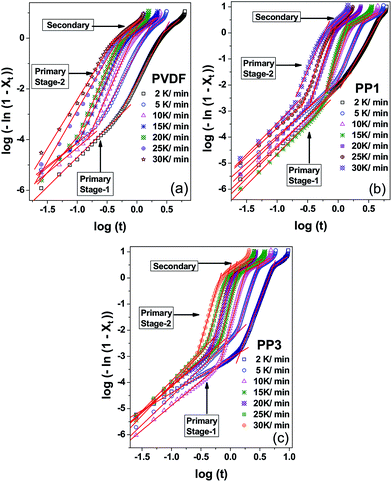 | ||
| Fig. 9 Avrami–Jeziorny plots of (a) PVDF and (b) and (c) PAni/PVDF blends calculated for different cooling rates. | ||
During the first stage of the primary crystallization, the values of n for all the samples lie within 1.8 < n < 2.5 (Table 3), which indicates the two-dimensional growth of particles with a constant nucleation rate.40 The first stage region becomes narrower with the increase in cooling rate (absent for PVDF at a higher cooling rate) but is gradually extended with increasing PAni extent within the PVDF matrix, indicating that PAni loading regulates the nucleation and crystal growth manner of the PVDF crystals within the blend.
During the second stage, the value of n reaches more than 3 for pure PVDF and even higher than 4 for PAni/PVDF blends, which may correspond to either a very complex crystallization process or to the growth of smaller crystallites.39,40 During the secondary crystallization process, all the n values remain within 2, which again indicates that the crystallization process concludes with a two-dimensional growth of particles at a constant nucleation rate. Furthermore, it can be observed from Table 3 that, at the same cooling rate, the Zc values for PAni/PVDF blends are considerably lower than that of neat PVDF. Considering the relation between the half-crystallization time t0.5 and the crystallization rate Zc, a lower t0.5 value should be accompanied with a fast crystallization rate, i.e. a higher Zc value. Thus, this again indicates that the inclusion of PAni could hinder the crystallization, although it offers a more specific area to crystallize under the non-isothermal scans. As a consequence, there are more sites available to nucleate, but the crystal growth proceeds at a slower rate. The net effects are the observed smaller grain size and lower crystallinity in the blends, as evidence in the aforementioned SEM and POM results.
 | (8) |
This can be simplified as
log[−ln(1 − Xt)] = log![[thin space (1/6-em)]](https://www.rsc.org/images/entities/char_2009.gif) K(T) − m K(T) − m![[thin space (1/6-em)]](https://www.rsc.org/images/entities/char_2009.gif) log log![[thin space (1/6-em)]](https://www.rsc.org/images/entities/char_2009.gif) φ φ
| (9) |
Liu et al.38 combined the Avrami and Ozawa equations to give a relationship between Xt and t as
 | (10) |
![[thin space (1/6-em)]](https://www.rsc.org/images/entities/char_2009.gif) φ vs. log
φ vs. log![[thin space (1/6-em)]](https://www.rsc.org/images/entities/char_2009.gif) t are illustrated in Fig. 10 for different samples at different degrees of crystallinity (20%, 40%, 60% and 80%), which are found to be linear for all the samples according to the theory.
t are illustrated in Fig. 10 for different samples at different degrees of crystallinity (20%, 40%, 60% and 80%), which are found to be linear for all the samples according to the theory.
The slope λ and F(T) obtained from the straight line fits are presented in Table 4, from which it is worth noting that the values of F(T) for a particular sample increase steadily with increasing relative crystallinity, indicating that, at a particular crystallization time, to achieve a higher degree of crystallinity, a higher cooling rate is necessary. The values of the parameter λ are almost constant for a particular sample. Moreover, it can be seen that, for an identical degree of crystalline transformation, the F(T) value is significantly higher for PAni/PVDF blends as compared to neat PVDF. Thus, to achieve the same Xt, a higher cooling rate is required for PAni/PVDF blends than for neat PVDF. This means that the crystallization rate of PAni/PVDF blends gradually become slower with increasing extent of PAni within the PVDF. These results are in accordance with those obtained from Jeziorny's model.
| Sample | Parameter | Xt (%) | |||
|---|---|---|---|---|---|
| 20 | 40 | 60 | 80 | ||
| PVDF | F(T) | 4.5 | 6.1 | 8.1 | 11.4 |
| λ | 1.50 | 1.53 | 1.60 | 1.67 | |
| PP1 | F(T) | 10.0 | 13.0 | 15.8 | 20.4 |
| λ | 1.48 | 1.53 | 1.55 | 1.62 | |
| PP3 | F(T) | 13.8 | 16.9 | 20.4 | 25.0 |
| λ | 1.46 | 1.49 | 1.53 | 1.57 | |
| Sample | Regime I | Regime II | ||||
|---|---|---|---|---|---|---|
| Kg (105) (K2) | U (kJ mol−1) | Range (T) | Kg (105) (K2) | U (kJ mol−1) | Range (T) | |
| PVDF | 0.21 | 0.53 | 407–412 | 0.36 | 4.89 | 413–418 |
| PP1 | 0.42 | 3.86 | 398–406 | 0.95 | 6.48 | 407–412 |
| PP3 | 0.87 | 8.39 | 400–410 | — | — | — |
log![[thin space (1/6-em)]](https://www.rsc.org/images/entities/char_2009.gif) φ = A − B/ΔTC2 φ = A − B/ΔTC2
| (11) |
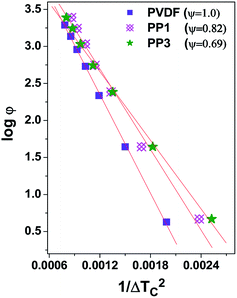 | ||
| Fig. 11 Linear plots following the eqn (10) for different homogeneously or heterogeneously nucleated samples with corresponding values of ψ. | ||
3.7 Effective activation energy of non-isothermal crystallization
To characterize the non-isothermal crystallization of melt polymers, the determination of the effective activation energy (EX) is essential. In this regard, the reaction model-independent isoconversional methods are advantageous as compared to the other methods. The isoconversional methods also enable to evaluate the dependence of EX on the conversion and temperature, which is considerably helpful in detecting and elucidating complex kinetics and the crystal growth mechanism in polymeric systems. Among the different existing isoconversional methods, the differential method of Friedman44 and the advanced integral method of Vyazovkin45 are the most appropriate to use, and thus, in the current investigation, the Friedman's method was used to evaluate EX for different samples.Usually, kinetic methods used in thermal analysis consider the process rates (dXt/dt) to be a function of only two variables: the temperature (T) and the extent of conversion (Xt) as46
 | (12) |
K(T) = A![[thin space (1/6-em)]](https://www.rsc.org/images/entities/char_2009.gif) exp(−EX/RT) exp(−EX/RT)
| (13) |
In all the isoconversional methods, the reaction rate at constant extent of conversion is only a function of temperature.46 Considering this, by taking the logarithmic derivative of the reaction rate at constant Xt, for constant f(Xt), the expression for EX from eqn (12) becomes
 | (14) |
According to Friedman's differential isoconversional method,44 using eqn (12) and (13), different effective activation energies (EX) can be determined for every degree of crystallinity from
 | (15) |
By selecting appropriate degrees of crystallinity (from 2% to 98%), the values of dXt/dt at a specific Xt for different cooling rates are correlated to the corresponding crystallization temperature at this Xt, i.e., TX for each sample. Straight line plots of the left-hand side of eqn (15) with respect to 1/TX for PVDF and its blends at three different conversions are depicted in Fig. S1.† The values of EX obtained from the slopes of the as-shown straight lines achieved for each conversion and for different cooling rates were plotted as a function of Xt for each samples, as shown in Fig. 12. Negative values for EX were observed always, which increased with the advance of the crystallization process. Moreover, the EX values of the PAni/PVDF blends are closer to zero than the pre-PVDF, indicating that they are crystallizing at temperatures closer to their maximum crystallization rate.47
The resultant EX dependencies can be utilized45,46 for estimating the parameters related to crystal growth by correlating the isoconversional principle with the Hoffman–Lauritzen theory.48 According to the Hoffman–Lauritzen theory,48 the temperature dependence of the linear growth rate, G, can be described as follows:
 | (16) |
 | (17) |
Using eqn (16) and (17), Vyazovkin and Sbirrazzuoli45 derived the temperature dependence of the effective activation energy of the growth rate as
 | (18) |
Fig. 13 displays the variation of EX with the average temperature for a particular Xt for different cooling rates (Tavg). The value of EX for all the samples increases with diminution of the average temperature, as can be found in a variety of polymer systems,47,51 which clearly indicates that the crystallization rate increases with decreasing temperature.47
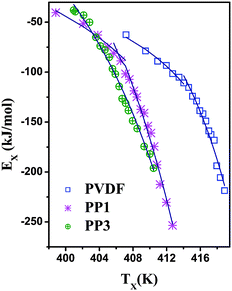 | ||
| Fig. 13 The dependence of the effective activation energy on average temperatures for PVDF and PAni/PVDF blends obtained by the Friedman's method. The solid lines represent the best fits to the eqn (18). | ||
As observed from Fig. 13, the EX (Tavg) dependence demonstrates discontinuities at 414 K (i.e., 141 °C) and 407 K (i.e., 134 °C) for PVDF and for the blend with low PAni content (PP1), respectively. However, no such discontinuous variation can be found for the higher PAni incorporated blend (PP3). The observed discontinuity may be attributed to a change in the crystallization mechanism. Different parameters related to the mechanism of crystal growth have been obtained from the fitting of EX (Tavg) data with eqn (18), as shown in Table 5. To incorporate any possible change in the crystallization mechanism, the parameterization of the higher temperature (T > 414; 407 K) and lower temperature (T < 414; 407 K) ranges of the EX (Tavg) for PVDF and PP1, respectively, were performed (solid lines in Fig. 13). It can be observed from Table 5 that the values of both Kg and U significantly increase at the higher temperature range, clearly ascribing to the change in the crystallization mechanism from regime I to regime II. Moreover, both Kg and U significantly increase with in situ PAni integration within PVDF. In the high temperature regime, the PVDF chains have a lower mobility for nucleation and growth than in the low temperature regime, and the mobility decreases further with the incorporation of PAni within the matrix and thus requires a higher energy for the growth of crystallites. This conclusion is parallel to that obtained from the aforementioned other analysis.
4. Conclusions
Results and analysis based on structural, morphological and non-isothermal crystallization kinetics investigations of PVDF and different PAni/PVDF blends clearly confirm that the nucleation and phase transition of PVDF macromolecules are significantly controlled by PAni in the non-isothermal crystallization process of the blends. During the melt-crystallization process, PAni serves as an efficient heterogeneous nucleation agent, and on the other hand it defends the β-phase to α-phase transition of PVDF, thereby increasing the percentage of the β-phase within the blend. From the analysis, it can also be concluded that PAni actually delays the crystal growth process, leading to a decrease in both TC and overall crystallinity of the blends. The higher values of the effective activation energy for the blends as compared to neat PVDF and the higher values of growth parameters obtained from the analysis of the average temperature variation of the effective activation energy by the modified Hoffman–Lauritzen theory also accomplish the same.Acknowledgements
The authors acknowledge the DST-FIST scheme of the Department of Physics, University of Kalyani and DST-PURSE program, University of Kalyani for providing the instrumental facilities. The authors also acknowledge Prof. P. K. Mandal, University of North Bengal, for providing POM facility.References
- A. Lovinger, in Developments in Crystalline Polymers—1, ed. D. C. Bassett, Springer, Netherlands, 1982, vol. 33, pp. 195–273 Search PubMed.
- P. Martins, A. C. Lopes and S. Lanceros-Mendez, Prog. Polym. Sci., 2014, 39, 683–706 CrossRef CAS PubMed.
- C. Ribeiro, V. Sencadas, J. L. G. Ribelles and S. Lanceros-Méndez, Soft Mater., 2010, 8, 274–287 CrossRef CAS PubMed.
- M. Sharma, G. Madras and S. Bose, Phys. Chem. Chem. Phys., 2014, 16, 16492–16501 RSC.
- M. Yin, Y. Zhu, R. Lv, B. Na and Q. Liu, RSC Adv., 2014, 4, 39491–39496 RSC.
- P. Costa, J. Silva, V. Sencadas, C. M. Costa, F. W. J. van Hattum, J. G. Rocha and S. Lanceros-Mendez, Carbon, 2009, 47, 2590–2599 CrossRef CAS PubMed.
- E. Piorkowska and A. Galeski, in Handbook of Polymer Crystallization, John Wiley & Sons, Inc., 2013, ch7, pp. 215–236, DOI:10.1002/9781118541838.
- Y. Wu, S. L. Hsu, C. Honeker, D. J. Bravet and D. S. Williams, J. Phys. Chem. B, 2012, 116, 7379–7388 CrossRef CAS PubMed.
- E. Freire, O. Bianchi, J. N. Martins, E. E. C. Monteiro and M. M. C. Forte, J. Non-Cryst. Solids, 2012, 358, 2674–2681 CrossRef CAS PubMed.
- F. Arai, K. Shinohara, N. Nagasawa, H. Takeshita, K. Takenaka, M. Miya and T. Shiomi, Polym. J., 2013, 45, 921–928 CrossRef CAS PubMed.
- I. Pillin, S. Pimbert and G. Levesque, Polym. Eng. Sci., 2002, 42, 2193–2201 CAS.
- Y. Okabe, T. Kyu, H. Saito and T. Inoue, Macromolecules, 1998, 31, 5823–5829 CrossRef CAS.
- L. T. Vo and E. P. Giannelis, Macromolecules, 2007, 40, 8271–8276 CrossRef CAS.
- J. Yang, P. Pan, L. Hua, B. Zhu, T. Dong and Y. Inoue, Macromolecules, 2010, 43, 8610–8618 CrossRef CAS.
- M. H. Rahman and A. K. Nandi, J. Polym. Sci., Part B: Polym. Phys., 2004, 42, 2215–2227 CrossRef CAS PubMed.
- R. Song, D. Yang and L. He, J. Mater. Sci., 2007, 42, 8408–8417 CrossRef CAS.
- D. Shah, P. Maiti, E. Gunn, D. F. Schmidt, D. D. Jiang, C. A. Batt and E. P. Giannelis, Adv. Mater., 2004, 16, 1173–1177 CrossRef CAS PubMed.
- W. Yu, Z. Zhao, W. Zheng, B. Long, Q. Jiang, G. Li and X. Ji, Polym. Eng. Sci., 2009, 49, 491–498 CAS.
- X.-Q. Liu, R.-H. Li, Y.-J. Pang, H.-Y. Ni and J. Chen, Polym.-Plast. Technol. Eng., 2014, 53, 539–549 CrossRef CAS PubMed.
- L. F. Malmonge, G. d. A. Lopes, S. d. C. Langiano, J. A. Malmonge, J. M. M. Cordeiro and L. H. C. Mattoso, Eur. Polym. J., 2006, 42, 3108–3113 CrossRef CAS PubMed.
- K. Shehzad, A. Ul-Haq, S. Ahmad, M. Mumtaz, T. Hussain, A. Mujahid, A. Shah, M. Choudhry, I. Khokhar, S. Ul-Hassan, F. Nawaz, F. Rahman, Y. Butt and M. Pervaiz, J. Mater. Sci., 2013, 48, 3737–3744 CrossRef CAS.
- J. N. Martins, M. Kersch, V. Altstädt and R. V. B. Oliveira, Polym. Test., 2013, 32, 862–869 CrossRef CAS PubMed.
- S. d. Sami, B. Mouna, M. Aymen, G. Fethi, D. Hassen and M. Abdellatif Belhadj, J. Phys. D: Appl. Phys., 2013, 46, 355101 CrossRef.
- H. Derouiche and A. B. Mohamed, Thin Solid Films, 2012, 526, 274–277 CrossRef CAS PubMed.
- L. F. Malmonge, S. d. C. Langiano, J. M. M. Cordeiro, L. H. C. Mattoso and J. A. Malmonge, Mater. Res., 2010, 13, 465–470 CrossRef CAS.
- E. P. Taylor, F. A. Landis, K. A. Page and R. B. Moore, Polymer, 2006, 47, 7425–7435 CrossRef CAS PubMed.
- S. Zulfiqar, M. Zulfiqar, M. Rizvi, A. Munir and I. C. McNeill, Polym. Degrad. Stab., 1994, 43, 423–430 CrossRef CAS.
- L. F. Malmonge and L. H. C. Mattoso, Polymer, 2000, 41, 8387–8391 CrossRef CAS.
- H. Luo, Y. Huang and D. Wang, Polymer, 2013, 54, 4710–4718 CrossRef CAS PubMed.
- M. C. Kuo, J. C. Huang and M. Chen, Mater. Chem. Phys., 2006, 99, 258–268 CrossRef CAS PubMed.
- M. S. Abdel Aziz, G. R. Saad and H. F. Naguib, Thermochim. Acta, 2015, 605, 52–62 CrossRef CAS PubMed.
- A. Asadinezhad, H. A. Khonakdar, L. Häuβler, U. Wagenknecht and G. Heinrich, Thermochim. Acta, 2014, 586, 17–24 CrossRef CAS PubMed.
- C. Marega and A. Marigo, Eur. Polym. J., 2003, 39, 1713–1720 CrossRef CAS.
- S. H. Kim, S. H. Ahn and T. Hirai, Polymer, 2003, 44, 5625–5634 CrossRef CAS.
- M. Avrami, J. Chem. Phys., 1940, 8, 212–224 CrossRef CAS PubMed.
- A. Jeziorny, Polymer, 1978, 19, 1142–1144 CrossRef CAS.
- T. Ozawa, Polymer, 1971, 12, 150–158 CrossRef CAS.
- T. Liu, Z. Mo, S. Wang and H. Zhang, Polym. Eng. Sci., 1997, 37, 568–575 CAS.
- C. Li, J. Vongsvivut, X. She, Y. Li, F. She and L. Kong, Phys. Chem. Chem. Phys., 2014, 16, 22145–22158 RSC.
- J. P. Jose, L. Chazeau, J.-Y. Cavaille, K. T. Varughese and S. Thomas, RSC Adv., 2014, 4, 31643–31651 RSC.
- Shalu, S. K. Chaurasia and R. K. Singh, RSC Adv., 2014, 4, 50914–50924 CAS.
- C. Li and Q. Dou, Polym. Adv. Technol., 2015, 26, 376–384 CrossRef CAS PubMed.
- A. Dobreva and I. Gutzow, J. Non-Cryst. Solids, 1993, 162, 1–12 CrossRef CAS.
- H. L. Friedman, J. Polym. Sci., Part C: Polym. Symp., 1964, 6, 183–195 CrossRef PubMed.
- S. Vyazovkin and N. Sbirrazzuoli, Macromol. Rapid Commun., 2004, 25, 733–738 CrossRef CAS PubMed.
- S. Vyazovkin, A. K. Burnham, J. M. Criado, L. A. Pérez-Maqueda, C. Popescu and N. Sbirrazzuoli, Thermochim. Acta, 2011, 520, 1–19 CrossRef CAS PubMed.
- D. A. D'Amico, V. P. Cyras and L. B. Manfredi, Thermochim. Acta, 2014, 594, 80–88 CrossRef PubMed.
- J. Hoffman, G. T. Davis and J. Lauritzen Jr, in Treatise on Solid State Chemistry, ed. N. B. Hannay, Springer, US, 1976, pp. 497–614 Search PubMed.
- D. S. Achilias, G. Z. Papageorgiou and G. P. Karayannidis, Macromol. Chem. Phys., 2005, 206, 1511–1519 CrossRef CAS PubMed.
- A. Toda, T. Oda, M. Hikosaka and Y. Saruyama, Polymer, 1997, 38, 231–233 CrossRef CAS.
- S. Vyazovkin and I. Dranca, Macromol. Chem. Phys., 2006, 207, 20–25 CrossRef CAS PubMed.
Footnote |
| † Electronic supplementary information (ESI) available. See DOI: 10.1039/c5ra15989j |
| This journal is © The Royal Society of Chemistry 2015 |

